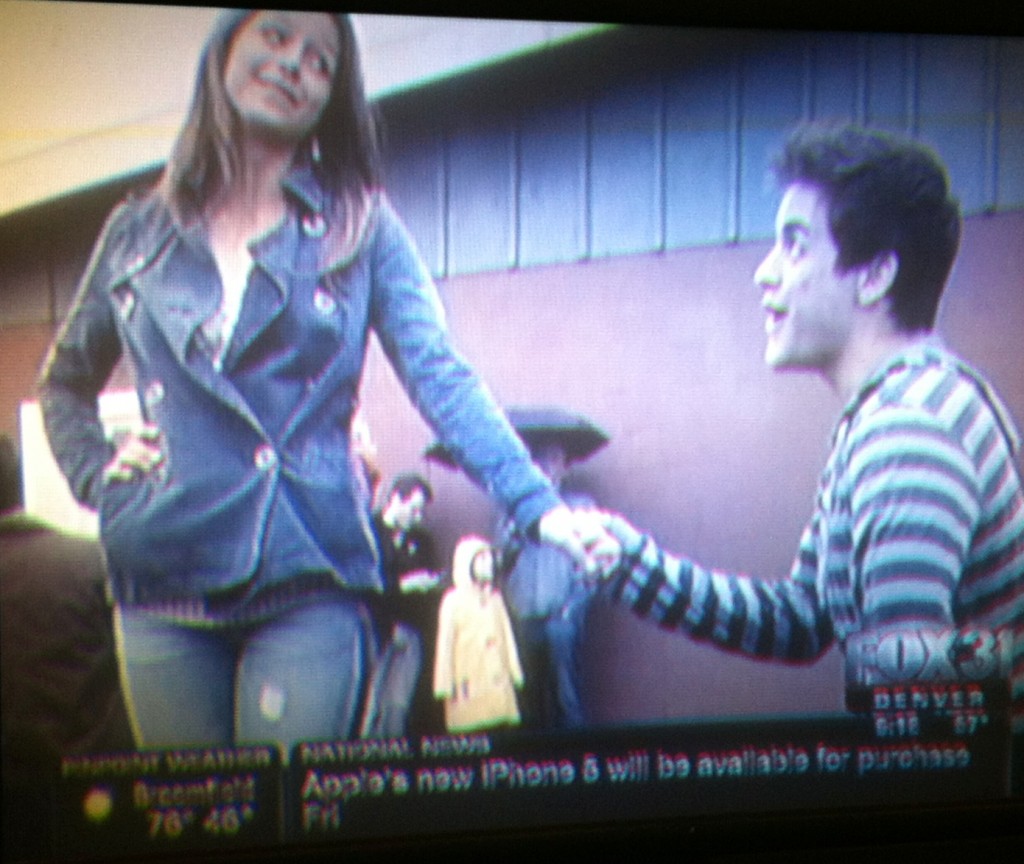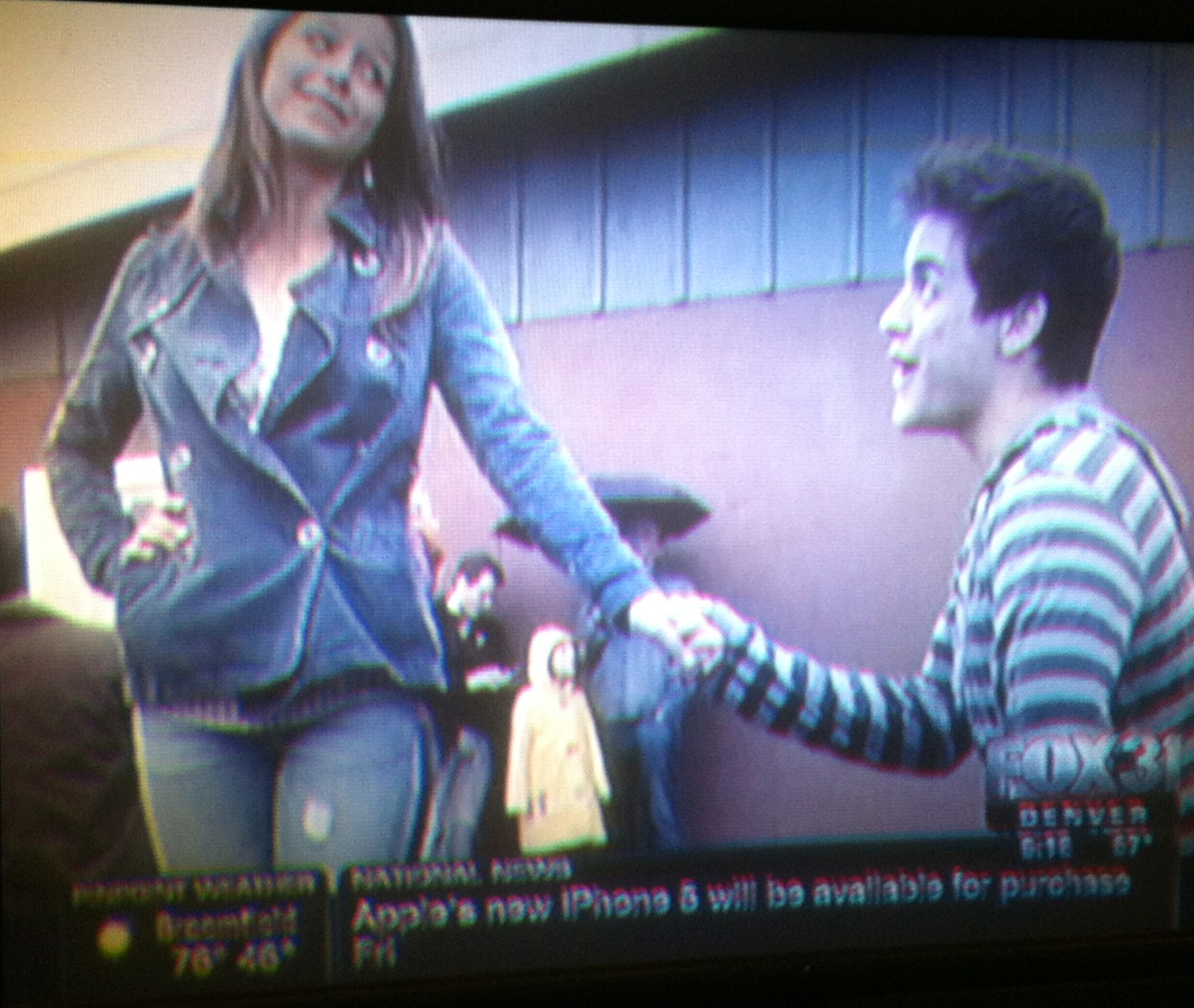
By John Moore
Sept. 17, 2012
It’s hard out there for a journalist in the internet age, when anyone can steal your work in a second using cut-and-paste, a screen-grab, a right-click or even an iPhone (see above). If you are a freelance photographer, forget being adequately paid for your work. Most would settle for simply getting credit for it. (But make no mistake – they deserve to be paid for it.)
A minor incident in the local media last week is a telling example of both the continuing erosion of newsroom resources in mainstream journalism today, and just how little control journalists have anymore over the content they own once it hits the internet.
Short story: The local Fox affiliate KDVR-31 lifted three photos from this blog without permission or offering credit to the photographers. It was a blatant example of short-cutting. I called them on it, and that did not meet with a friendly response.
“We don’t need a lecture about journalistic ethics from you,” emailed vice-president of news Ed Kosowski.
Ouch. My first reaction was, “ … Perhaps you do.”
This was not going to go well.
But actually, it did, and, after an exchange of further information, Kosowski issued a kind apology.
Longer story: I wrote this feature story for The Denver Post on Sept. 9 about Littleton’s Melissa Benoist joining the cast of Fox TV’s “Glee.” As an added feature, I posted photos to my blog here at culturewest.org of Melissa growing up performing on Colorado stages. Some of these photos were long-forgotten publicity photos I collected over the years as The Denver Post’s theater critic. Others were Denver Post staff photos from story assignments I filed during that time. I credited the photos.
Right after Benoist’s debut episode on “Glee” aired Thursday, KDVR teased an interview with the hometown girl by entertainment reporter Chris Parente. I was soon irked for two reasons: First, I saw screen-grabs of my blog – uncredited – showing photos of Melissa performing in two shows for Town Hall Arts Center in 2006-07. And, more troubling, a staff photo owned by The Denver Post showing Benoist performing in the rainy parking lot outside the Country Dinner Playhouse just hours after the landmark theater barn was chained and padlocked in 2007. (The Post photographer was Kathryn Scott Osler). The second thing was that Parente incorrectly stated in his report that Benoist wowed the crowds as Evita in the production. She was 16 then – she played Peron’s mistress. It was an honest, if sloppy mistake, but speaking of uncredited work – that credit belonged to Joanie Brosseau.
Here’s what you need to know about copyright, according to the Professional Photographers of America:
- Under the Federal Copyright Act of 1976, photographs are protected by copyright from the moment of creation. You don’t have to license them, register or claim them. You can, but you don’t have to. It’s yours, as much as the “Mona Lisa” belonged to da Vinci.
- Unless you have permission from the photographer (or whoever he/she gives ownership to), you can’t copy, distribute, publicly display or create derivative works from photographs. That means no scanning and sending them to others. No putting them online. No “right-click, save-image-as” button-pushing.
Clearly, KDVR had no right to use that Denver Post photo by simply lifting it from a third party. But the other two were publicity photos, and that’s murkier territory. They show Benoist in “Footloose” and “Cinderella,” photos that were publicly issued by Town Hall back in 2006 and 2007. While Town Hall would have been thrilled to have KDVR care enough to air those photos (then or now), they would not be readily available to anyone today who wasn’t compiling them as they went along. Not even on a Google search. We call such pictures “archival photos.” To get them, KDVR would have had to ask for them.
The ethical route would have been to acquire them – and seek permission to use them – from the organizations that owned them. Instead, they took a short cut.
And, after some reconsideration, Kosowski agreed. Here’s the email he sent this morning:
John,
Appreciate the additional information. We’ve done some back-tracking here to find out what happened and how this fell through the cracks. Another reporter, Hema Mullur, had been working on the story and she obtained those photos from your blog. She wasn’t able to finish the story (we were going back and forth with the father for an interview) before leaving for vacation, and she passed the information/photos/links/video to Chris Parente.In that handover, Hema should either called or emailed you for permission/courtesy or told Chris to do that. In the future, we’ll be more careful and will make sure we ask for permission and credit any third-party source.
I apologize for the oversight and I’m glad you brought it to our attention.
Ed.
A classy and appropriate response.
It’s worth reiterating that the theater companies, and their individual photographers, would have been happy to give KDVR those photos for its Benoist story. But newsrooms have fewer resources and less time than ever to get the little things done. And deadlines don’t care about your time and resources. Sometimes corners get cut.
The unfocused world of publicity pictures
This whole subject of theater publicity photos is itself a gray area. Here’s (sort of) how it works:
When a theater company is getting ready to open a play, many take their own publicity pics on whatever borrowed digital camera they can borrow, and the results are generally pretty amateurish. They submit these pictures to the media in the hope that they will be as widely distributed as possible. Even though the official policy at newspapers like The Denver Post is to cite the source of every photo, often there is so little effort put into the quality of these pictures that the companies don’t even submit the photographer’s name for individual credit. In those cases, we will simply say, “Photo provided by Generic Theatre Company.”
Other companies contract with established freelance photographers who, in exchange for a fee that can range from as little as nothing to $500 or more, turn over the photos – and their rights to them – to the theater company. But that does not absolve ethical media outlets from crediting the individuals for their work whenever possible. In Denver, the bigwig photographers include Michael Ensminger (Curious Theatre and others), P. Switzer (Arvada Center) and, until recently, Terry Shapiro (Denver Center Theatre Company).
Freelancers like Brian Miller scramble for every morsel of work they can get working with smaller theater companies that have little-to-no budget to pay for publicity pictures. (If only they realized how essential the quality of production photos is for how they get played on newspaper pages). Miller often works for a flat $75 fee on jobs that average about 30 hours of his time. He also often works for free. The only way to make money in this business, he says, is to shoot weddings. Instead, he shoots theater.
Miller took one of the pictures that KDVR used without permission or credit. For $2.50 an hour, he figures, a simple credit line from a big-time local TV news channel would have been a nice boost.
In this age of Google image searches, it is becoming harder and harder for the Brian Millers of the world to control where their images pop up around the internet. But remember – creation is copyright. When someone steals your work, Miller said, that’s when it becomes necessary for you to register that copyright and take the offender to court.
Freelance photographers have long used watermarking symbols to force potential copiers of their work to actually purchase an original file. And the internet is now making it possible for photographers to embed invisible copyright information within the data of their online photos. It’s called “Exif.” Use it, and whenever someone copies your photo off the internet, they see who owns it – although that does not prevent them from copying it, regardless. Many large media organizations use new software that disables readers from even getting the option to copy an image when they right-click on it. But that doesn’t stop them from screen-grabs.
Did I mention this is a murky area? Just last week, a local theater company sent out a Denver Post staff photo from a previous staging as its publicity photo for the coming remount. Talk abut confusing.
And you might be worried after reading this that almost any of us with a Facebook page has skirted this copyright law in some way. But Facebook is different. By uploading anything to that site, the owner gives away the exclusive copyrights to Facebook. It’s a bit of an open season on content.
Violators will always find a way around photographic piracy. But if anyone should understand the complexities and consequences of the issue, it should be mainstream media outlets whose revenues are being siphoned off by new media sources.
The message of the Professional Photographers of America: “Even small levels of infringement—copying a photo without permission—can have a devastating impact on a photographer’s ability to make a living.”
In the end, this is just a reminder about doing the right thing.
